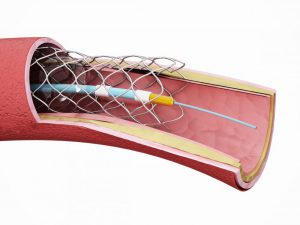
Heart is known as the most strongest Muscle in your Body. Heart is a muscle which pumps blood throughout your body and changes the DEoxygenated blood with the fresh oxygenated blood and then transports it to the rest of your body, Including your Brain(The Most Hard Working:). Coronary Arteries are located in the Heart where aorta(The Biggest Artery in your body) branches off into two main Coronary Blood Vessels . These arteries are further divided into small ones which supply the Oxygenated Blood to the entire Heart. The Right And Left Coronary arteries supply the blood to their parts Respectively(Left to left and Right to right). These are the only arteries which supply blood to the Heart Muscle. Which makes them very Important for the Heart as it helps them to move.
Coronary Artery Disease(The Most common Heart Disease) also known as CAD and atherosclerotic Heart disease is when the Heart’s Major arteries known as Coronary artery suffers damage and get narrow due to Fatty deposits, plaques , build up in the coronary artery which affect the supply of oxygenated blood to the heart and make it very hard for the heart to get the sufficient amount of Oxygenated blood which affects the health of the heart.
Furthermore, Coronary artery disease starts with damage to the inner layer of the vessel which gives rise to binding of platelets, Building up of fatty plaque deposits at the site of injury . These deposits consist of Cholesterol and other cellular waste products. These deposits could lead to blocking of the artery or blocking the blood flow to the heart and then which leads to a heart attack.
The Impact of this disease on individuals and society is that there are More than 10 million cases per year(India) where this disease can be treated but can last for a year or life long where in most cases the patient dies from it.
The symptoms of coronary artery disease are –
1.Chest pain
- Heartburn, Weakness , Extreme sweat
- shortness of breath
- indigestion
- Heart Attack.
Treatment for this disease include medication, Surgeries, Lifestyle changes and angioplasty.
Lifestyle changes includes , eating healthy food , Exercising regularly in order to keep your heart beat proper and fit. and also quit sources which are injurious to health such as smoking and drinking alcohol.
Medications include:
- Statins: These are the only medications demonstrated to have a positive impact on outcomes in CHD, but if a person has another underlying cholesterol disorder, they may not work.
- Low-dose aspirin: This reduces blood clotting, lowering the risk of angina or a heart attack.
3.Beta blockers: May be used to reduce blood pressure and heart rate, especially in a person who has already had a heart attack.
4.Nitroglycerin patches, sprays, or tablets: These control chest pain by reducing the heart’s demand for blood by widening the coronary arteries.
- Angiotensin -converting enzyme (ACE) inhibitors: These lower blood pressure and help to slow or stop the progression of CHD.
6.Calcium channel blockers: This will widen the coronary arteries, allowing greater blood flow to the heart, and reduce hypertension.
Surgery:

Surgery can open or replace blocked arteries, if the blood vessels have become very narrow, or if symptoms are not responding to medications:
1.Laser surgery: This involves making several tiny holes in the heart muscle, which encourage the formation of new blood vessels.
2.Coronary bypass surgery: The surgeon uses a blood vessel from another part of the body to create a graft that can bypass the blocked artery. The graft may come from the leg or an inner chest-wall artery.
3.Angioplasty and stent placement: A catheter is inserted into the narrowed part of the artery. A deflated balloon is passed through the catheter to the affected area. When the balloon is inflated, it compresses the fatty deposits against the artery walls. A stent, or mesh tube, may be left in the artery to help keep it open.
And only in extreme cases where heart is badly damaged a heart transplant may be carried out.
These surgery could be a problem for the patient as these are very costly and may lead to economic crisis for the family.
Some religions also do not allow their followers to transplant organs which could lead to death of the patient.
Transplantation or these surgery could play a major role in the treatment of this disease as these will help to regain the proper flow of oxygenated blood to the heart again and if not treated this disease could lead to heart failure and improper blood circulation in the whole body .